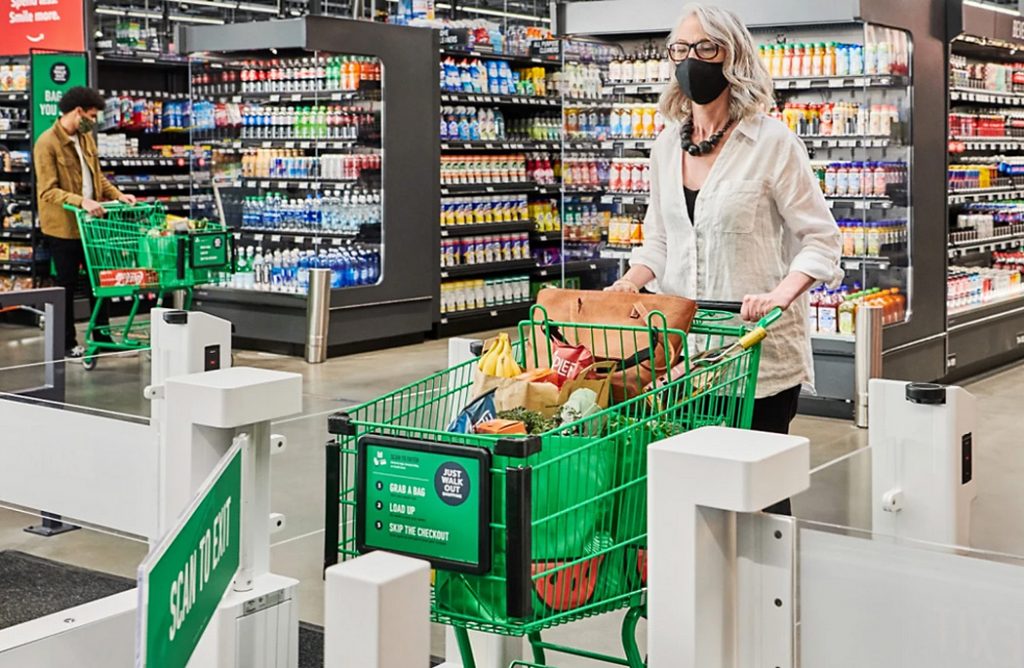
Maybe it’s because I’m a tech geek, but I love how tech is changing the shopping experience, from scanning my own items to paying just by holding my iPhone near the credit card reader.
And I can’t wait to give Amazon’s “Just Walk Out” technology a try. You walk around the store, select the stuff you want to buy—and then simply walk out. As you walk out, your credit card is debited and a receipt is sent to your phone.
No lines, no scanning: you just walk out.
How does it work? Amazon uses a combination of computer vision, sensor fusion (which combines multiple sensor data into a single image), and artificial intelligence to track what you’re picking up. (And putting back.) A review by GeekWire referred to it as a “shopping surveillance system.”
Apparently it works. Amazon began using Just Walk Out tech several years ago in nearly 30 Amazon Go convenience stores around the country. And in June for the first time Amazon opened a full-scale Amazon Fresh grocery store with Just Walk Out in Bellevue, Washington.
Based on their experience with this store, Amazon will decide whether to offer this same shopping experience in their other Amazon Fresh stores in the U.S.
When you first enter the store, you can “log in” by using their scanner to scan the QR code in your Amazon app; have your palm scanned if you have an Amazon One account; or insert a credit or debit card that’s linked to your Amazon account.
Then you simply start filling your cart—produce, frozen food, snacks, fish, staples, and anything else you’d find in a regular grocery store. The system tracks what you take. Then when you leave, your credit card is automatically charged.
The store also has some traditional checkout lanes for those who don’t want the geek experience (and who don’t mind waiting in line).
Amazon is, of course, beginning to license their Just Walk Out technology to other enterprises. We will likely see it in other stores in the future.
We seem to be headed toward a cashless future—a trend that was greatly boosted by the pandemic. Money has germs, and many people who had been in the habit of using cash shifted to electronic payment.
And more specifically, to “contactless payment.” Don’t know why this appeals to me so much, but I loved it when Chase sent me a new contactless credit card a couple months ago. No more swiping, no more inserting. Simply hold it near the credit card reader and payment is made. And for some reason, the transaction is a lot faster.
But even better, I recently got a new iPhone and am finally able to use Apple Pay. I’ve associated my Chase credit card with my Apple Pay account. And now when I want to pay, I simply double press the sleep/wake button and wave my phone near the credit card reader. The transaction is immediate, just like with my contactless credit card. Information about the transaction is then automatically stored in the Apple Wallet app on my iPhone.
I understand that Google Pay and Samsung Pay work similarly if you have an Android phone.
If you’re shopping at Walmart, however, you won’t be able to use any of these payment systems. That’s because Walmart has chosen to go with a different technology—probably because they want to have a record of your purchases in order to send you notifications of items on sale. But in some ways, I like their offering even better.
You simply download the Walmart App and associate a credit card with it. Then when it comes time to pay, you select Walmart Pay in the app and point your phone’s camera at the QR code on the checkout terminal’s display. Your card is instantly debited, and the receipt is stored in your phone.
This is great if you ever need to return an item. All your receipts are stored on your phone and you simply present the specific receipt at the service desk. They use a device to scan a code on the receipt and then credit your account for the cost of the item you’re returning.
As we race toward a cashless society, it’s hard to remember what it was like when we paid for most purchases with cash or check. China is rapidly heading toward being completely cashless, but Sweden is leading the way, with plans to be the first cashless nation in the world in 2023. Only 6 percent of payments in Sweden are currently made with cash.
As you might expect, there are some downsides, such as the challenge for those who don’t have credit cards or even bank accounts.
But for geeks like me, it’s all fun.
Find column archives at JimKarpen.com.
